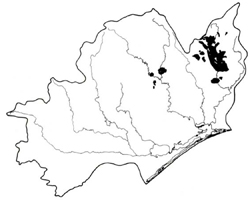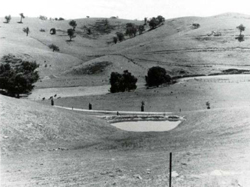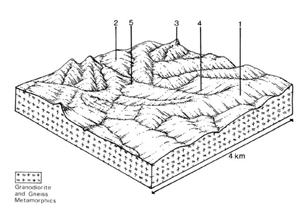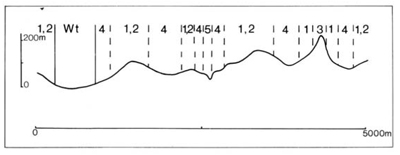Dargo (Do)
 | Area: 380 sq. km (1.9%) The plutonic and related gneissic rocks of the Dargo land system have been deeply weathered and eroded to levels below the surrounding, resistant, metamorphic or sedimentary rocks. The deep weathering may have occurred as long ago as the Mesozoic. The surrounding, resistant aureoles have restricted incision by the outflowing streams and this has allowed storage of colluvium on the lower slopes and of alluvium in valley floors. The larger occurrences of which are mapped in Walnut land system. Topography is hilly to gently undulating. |  Rounded hills and undulating footslopes, mostly cleared for grazing. |
| The coarsely-crystalline plutonic rocks weather relatively easily to form soil. The texture of which depends on the mineral composition and the degree of weathering of the parent rock. The granitic rocks, which are highest in quartz and potassium feldspars, produce coarse-textured soils, whereas those highest in sodium-calcium feldspars form more clayey soils. Most soils have clay subsoils with a well-developed, blocky structure and a red colour indicating good drainage and the presence of iron oxides. On some slopes deep, light-yellowish-brown, rather sandy soils occur on lag deposits containing abundant, partially-weathered, feldspar grains. Most soils are mildly acidic to neutral. There is a reported instance of soil salinity, however it is unlikely to he a significant hazard in the land system. Erosion is more of a hazard here. The native vegetation, now largely cleared, appears to he mainly grassy forest II. | ||
| CLIMATE Rainfall, mean (mm) Temperature, mean (°C) Seasonal growth limitations |
Annual 600 - 900; lowest July (40 - 70), highest October (60 - 90) Annual 12 - 14; lowest July (8 - 10), highest February (19-21) Temperature <10°C (av.): May - September Rainfall < potential evapotranspiration: November – March |
| GEOLOGY Age, lithology |
|
| PHYSIOGRAPHY Landscape Elevation range (m) Relative relief (m) Drainage pattern Drainage density (km/km2) |
Rounded hills and undulating footslopes 160 - 750 80 - 180 Dendritic 4 – 6 |
| PRESENT LAND USE |
Minor proportion uncleared: hardwood forestry (minor products); apiculture |
 |  |
| LAND COMPONENT Percentage of land system Diagnostic features | 1 40 Moderately steep slopes | 2 30 Gentler slopes on broad ridge crests and spurs | 3 5 Steeper rocky slopes and peaks | 4 15 Drainage depressions deposits | 5 10 Valley flats |
| PHYSIOGRAPHY Slope %, typical and (range) Slope shape | 15 - 20, (10 - 40) Convex or concave | 8 - 12, (0 - 20) Convex or concave | Variable, (20 - 50) Straight | 5, (0 - 10) Concave | 2, (0 - 3) Straight or concave |
| SOIL | |||||
| Parent material | Granite, granodiorite, diorite and gneiss | Colluvium | Alluvium | ||
| Description | Mainly black or brown sandy loam topsoil grading into reddish brown, brown or mottled yellowish brown blocky clay subsoil; some deep light yellowish brown uniform loamy sand on crests | Similar to components 1 and 2 but probably more uniform loamy sand, often stony; rock outcrop common | Black clay loam or clay grading into dark yellowish brown to grey mottled clay loam or clay | Little differentiated dark greyish brown sandy loam and mottled greyish brown sandy clay loam grading into clay at depth | |
| Classification | Mainly Reel Podzolic Soils: some Brown or Yellow Podzolic Soils: some Brown Earths Dr4.22, Dr2.21, Dr2.22, Db2.21, Dy3.21, Dy2.42, Gn2.11, Gn2.15, Gn3.14, Uc4.11 | Wiesenboden, Black Earths Um5.52, Ug5.1 | Alluvial Soils. Wiesenboden Uc1.21, Uc1.23, Uc5.21, Gn4.72 | ||
| Surface texture | Sandy loam, but varying from loamy sand to sandy clay loam | Clay loam to clay | Sandy loam to sandy clay loam | ||
| Surface consistence | Hard when dry. friable to firm when moist | Firm to very firm when moist | Loose to slightly hard when dry | ||
| Depth (m) | Commonly 0.7 - 1.2 | >2.0 | >2.0 | ||
| Nutrient status | Moderate | Moderate | Low to moderate | ||
| Available soil water capacity | Low to moderate | Moderate | Low to moderate | ||
| Perviousness to water | Slow to moderate | Slow | Moderate to rapid | ||
| Drainage | Mainly good | Poor to somewhat poor | Poor to good | ||
| Exposed stone (%) | Up to 10, mostly 0 | 0 | 0 | ||
| Sampled profile number | 45, 46 | 54 | - | - | - |
| NATIVE VEGETATION Structure of vegetation and characteristic species of dominant stratum (+ Predominant species) | Grassy open forest II: Mostly mixed forests with composition and predominant species variable — including E. albens (in east), E. bridgesiana, E. dives, E. goniocalyx, E. globulus, E. globoidea (lower elevations), E. macrorhynch,a E. rubida, E. stellulata | Limited data — probably open forest I, II with species similar to components 1 and 2 | Mainly grassy open forest II: E. viminalis+, E. radiata Occasionally woodland II: E. goniocalyx | Grassy open forest II: E. melliodora+ (higher better drained terraces): E. ovata+ with or without E. stellulata (lower poorer drained terraces) | |
Disturbance | Affected process and trend | Primary resultant deterioration | Casual activities | Primary off-site process | ||
Form | Susceptibility of components | Incidence with components | ||||
— reduction in leaf area, rooting depth and/or perenniality |
|
|
|
|
|
|
|
|
Wind erosion |
3; high 3: low |
Uncommon; locally severe on exposed slopes, especially at high elevations |
Clearing, logging, burning, overgrazing, road and dam building and other earth-moving activities, rabbit burrowing, trafficking by stock and vehicles. |
- |
|
With Reduced infiltration |
Sheet and rill erosion |
3; low 4; moderate 1,2,4; moderate 3: high |
Uncommon |
As for sheet and rill erosion above |
Increased flash flows |
|
Increased loss of topsoil cohesion |
Wind erosion |
3,5; high 3; low |
Uncommon; locally severe on exposed slopes, especially at high elevations |
As for wind, sheet and rill erosion above |
Increased sediment load |
| ||||||


